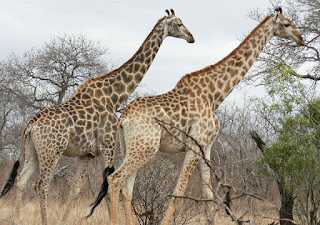Girafas perigo de extinção
créditos: Stephanie Pilick/ Getty
"Giraffes are facing 'silent extinction"
Sir David Attenborough
Especialistas alertam para o perigo de extinção das Girafas após um grande declínio da espécie.
Segundo a actualização da IUCN RED List of Threatened Species, a girafa, animal mais alto do mundo passou a constar dela. Em 30 anos o número de girafas reduziu 40%.
Girafas entre as espécies em vias de extinção
créditos: Nature America US
"The update also reveals a devastating decline for the giraffe, driven by habitat loss, civil unrest and illegal hunting. The global giraffe population has plummeted by up to 40% over the last 30 years, and the species has been listed as Vulnerable on the IUCN Red List.
IUCN Red List
Nesta lista oficial, que é elaborada pela International Union for the Conservation of Nature (IUCN), foram ainda acrescentadas 700 novas espécies de aves, recentemente descobertas, sendo que 13 delas estão já extintas.
Nesta nova actualização sobre as girafas, o número de animais reduziu, nos últimos 30 anos. De 157 mil passou para 97 mil, estando agora na categoria de “vulnerável”, segundo o IUCN.
As razões são várias, tal como o crescimento da população em África, que faz com que o habitat dos animais seja ameaçado, a transformação das terras selvagens em terras agrícolas e a desflorestação.
A caça ilegal é outra das razões apontadas para a presente situação.
Também as guerras civis estão a contribuir para a diminuição destes animais. As girafas já não existem em sete países onde antes habitava.
No entanto, também há boas notícias. Nesta actualização, os especialistas adicionaram um peixe que se pensava extinto na década de 60 mas que, afinal, voltou a ser visto. Este peixe é de Madagáscar.
Foi ainda recuperado da lista um pássaro de olhos brancos, o Seychelles, depois de terem sido feitos vários esforços de conservação da espécie.
Seychelles white-eye bird
créditos: Getty Images
Há muito que se fala dos efeitos das acções do Homem no mundo animal, sobretudo no que concerne a extinção em massa de várias espécies, quer pela destruição de muitos lugares selvagens que se tornam terras agrícolas quer pela poluição ou caça ilegal.
Estas acções, segundo um estudo, farão com que cerca de dois terços de animais selvagens se extinga até 2020.
Gorila oriental
créditos: Autor não identificado
Animais como o gorila oriental ou o tubarão-baleia foram também anexados à lista vermelha de animais em perigo de extinção, entre mais de 24 mil outras espécies que também estão em risco, num total de 85 mil espécies estudadas. A lista mostra-nos assim a verdadeira crise de extinção global de diversas espécies.
Nesta nova actualização sobre as girafas, o número de animais reduziu-se, nos últimos 30 anos, de 157 mil para 97 mil, estando agora na categoria de “vulnerável”, segundo o IUCN. As razões são várias, tal como o crescimento da população em África, que faz com que o habitat dos animais seja ameaçado, a transformação das terras selvagens em terras agrícolas e a desflorestação. Também as guerras civis estão a contribuir para a diminuição destes animais. A caça ilegal é outra das razões apontadas para a presente situação
Giraffes grazing in the Nairobi national park
Photograph: Grayling Kenya Photo/Stuart Price/MEAACT Kenya
Giraffes facing extinction after devastating decline, experts warn. Latest update to the Red List of Threatened Species shows world’s tallest animal is on the brink, but some good news for Madagascan freshwater fish.
The world’s tallest animal is at risk of extinction after suffering a devastating decline in numbers, with nearly 40% of giraffes lost in the last 30 years, according to the latest “red list” analysis.
The authoritative list, compiled by the International Union for the Conservation of Nature (IUCN), has also added more than 700 newly recognised bird species, but 13 of these are already extinct.
It says wild relatives of important food crops, such as mangoes and sunflowers, are now in danger of extinction, cutting the ability to safeguard food supplies by breeding new varieties resilient to drought and disease.
Giraffes have seen a 38% decline in their numbers since 1985, falling from about 157,000 to 97,500 today.
Population numbers, thousands : see the graphic.
Seychelles white-eye bird
credits: Jeff Watson/Nature Seychelles
Photo License: All Rights Reserved
But there is a little hopeful news in the list as well with the rediscovery of a few species thought to have been lost, such a Madagascan freshwater fish which had not been seen since the 1960s, and the recovery of the Seychelles white-eye bird after conservation efforts. Read more here
So sad. Giraffes are sweet animals. Can we the human change ther behaviour on the planet? Let's pledge for Giraffes by posting.
Geração 'green'
11.12.2016
References:
Observador/Ciência
The Red List/IUCN
The Guardian/WildLife








No comments:
Post a Comment